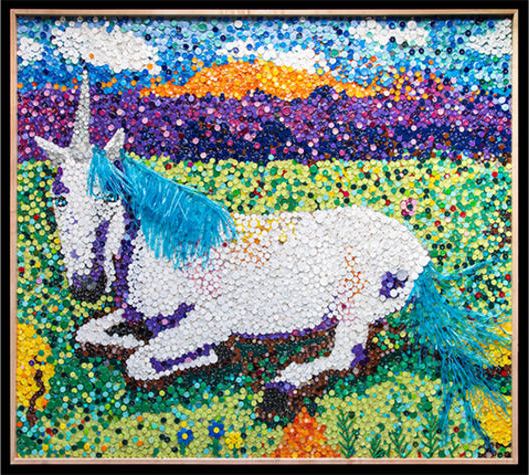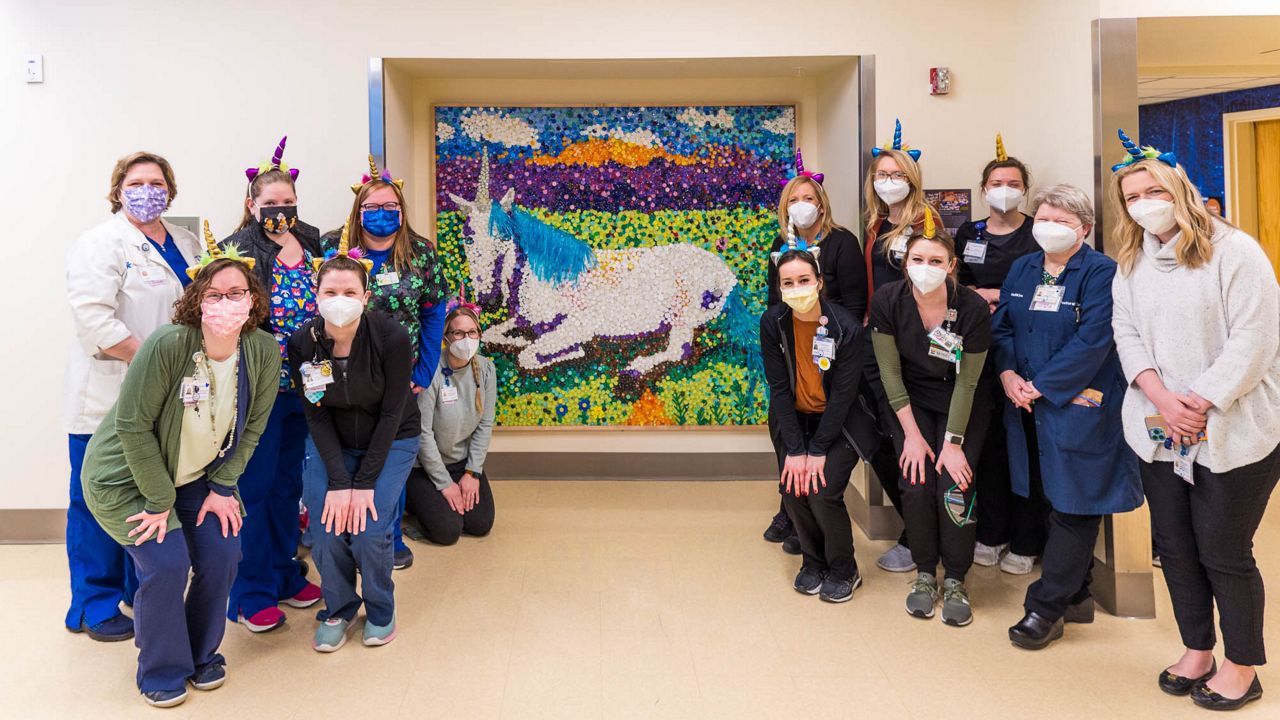LEXINGTON, Ky. – There’s a magical new piece of artwork displayed on the fourth floor at Kentucky Children’s Hospital. Unity “MoonPie” McSparkles is a 6-by-5-foot mosaic unicorn display made entirely of plastic waste from the hospital.
What You Need To Know
- Art created from waste plastic
- Piece is displayed on fourth floor of Kentucky Children's Hospital
- Unicorn symbolizes hope and healing
- Part of UK Arts in HealthCare program
After years of collecting and saving thousands of pieces of recyclable medical plastics from the landfill, hospital and UK Arts in HealthCare staff, along with other members of the hospital community, set out this past year to create a collaborative work of public art. The mosaic is made up of thousands of vial caps, oral syringe caps, clamps, tubes and other pieces of hospital plastic.
“Sometimes magic and human connection occur in the unlikeliest of places,” said Jason Akhtarekhavari, manager of UKHC Arts in HealthCare, who worked in tandem with his staff members Sarah Timmons and Jim Shambhu. “It often occurs in the darkest of hours and in times of great sadness, struggle and pain. This unicorn touched many individual lives and provided the “magic” that was needed to those who participated in its creation. It built a meaningful web of human connection that will echo in time and be felt by many who see this creation in the months and years to come.”
The idea for “MoonPie” was inspired by Tilda Shalof, a nurse in Canada who spent nearly three decades collecting discarded medical plastic to create a colorful mosaic. Kentucky Children’s Hospital (KCH) nurses approached the Child Life staff about creating something similar for their hospital. The Child Life Program is a specialized service providing play opportunities for patients of the Kentucky Children's Hospital and their families.

The plastic was collected in buckets placed at nurse’s stations around KCH to collect caps of medication vials. Staff from around the hospital, including Markey Cancer Center and central pharmacy in Chandler, saved their plastic waste as well. After some discussion, KCH staff ultimately chose to create a unicorn because it symbolizes hope, healing and magic.
Lexington artist Christine Kuhn joined the team to provide guidance with the design and construction process, but the piece was created entirely by KCH staff.
“It is a visual reminder that time moves forward,” said Erin McAnallen, expressive arts resource specialist for KCH Child Life. “It did cause a bit of humor and consternation when we tried to get more of the long, green caps to represent vegetation in the mural and were told by the pharmacy, ‘Morphine doesn’t come like that anymore.’”
The COVID-19 pandemic slowed the creation process, as small groups only could work on the project at any given time, masked and socially distanced.
A contest took place among KCH staff and patients to name the piece of community artwork. After being named Unity “MoonPie” McSparkles to reflect the repeating stacked disks of plastic, KCH staff asked the Chattanooga Bakery Inc. for permission to use the trademarked MoonPie name, and permission was granted.
Aside from the artistic elements, the project kept some plastic from going to a landfill.
“I think that's the idea whenever we think about the immensity of waste. It does pale in comparison to the overall amount of plastic waste, but I think part of it is the idea that you're showing people what's possible,” Akhtarekhavari said. “If we take a little time to think about the ways that we can be creative with some of our waste problems and how it's not just a matter of melting the plastic back now and reusing it, but there are creative ways. There's many different examples of artists getting very creative with waste to create art, so it's not a new concept. Even though it's small and scale, I think what's important is getting that message out and having people think about the possibility.”
According to its website, the UK Arts in HealthCare program is responsible for multiple forms of art showcased throughout UK hospitals and clinics. More than 2,100 works of art featuring local, national, regional and international artists, can be found in lobbies, waiting areas, hallways, outdoor spaces, patient and exam rooms. Seven rotating galleries feature as many as 11 unique visual art exhibits per year.
Adding an art element to the hospital environment has multiple positive effects.
“The thought of the design element was paramount to how that building would be created,” Akhtarekhavari said. “There's many things the art does, and there's a lot of research behind it. It's been demonstrated it can reduce anxiety, help manage pain and even shorten the length of stay. It's creating that environment where you oftentimes familiar objects, whether it's photography of rural landscapes, that help relax you, put you at ease and remind you of where you're from. Maybe it's something colorful and playful that helps put a smile on your face to break up the clinical atmosphere. A lot of times it's sort of common sense. We live in a research-driven world, but the bottom line is, whether it's your home, or any facility you go into, when there's been thought put into the environment that you're creating, it's going to have a big impact on the patients, families, visitors and staff.”



